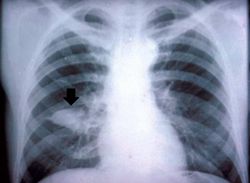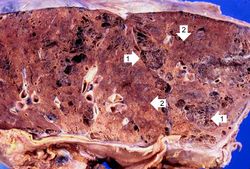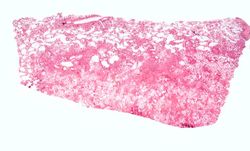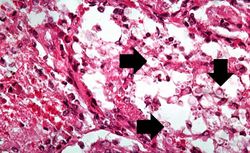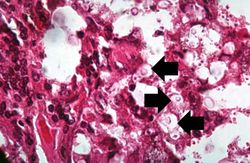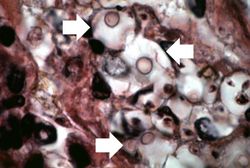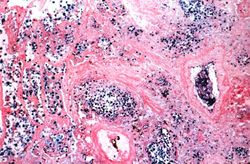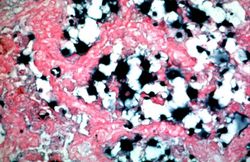Difference between revisions of "IPLab:Lab 10:Cryptococcosis"
| Line 22: | Line 22: | ||
File:IPLab10Crypto12.jpg|This is a touch prep of fresh lung tissue that was allowed to air dry and then stained to show the mucopolysaccharide capsule around the cryptococcal organisms (arrows). | File:IPLab10Crypto12.jpg|This is a touch prep of fresh lung tissue that was allowed to air dry and then stained to show the mucopolysaccharide capsule around the cryptococcal organisms (arrows). | ||
</gallery> | </gallery> | ||
| + | |||
| + | == Study Questions == | ||
| + | * <spoiler text="How is Cryptococcus neoformans usually transmitted to man?">Cryptococcus neoformans is present in the soil and in bird (particularly pigeon) droppings. | ||
| + | |||
| + | The organism infects humans when it is inhaled.</spoiler> | ||
| + | * <spoiler text="Who is susceptible to infection with C. neoformans?">Normal healthy people can get cryptococcal meningoencephalitis but cryptococcal infections are more common in individuals | ||
| + | |||
| + | (1) who receive high-dose corticosteroids and/or | ||
| + | |||
| + | (2) who have AIDS, leukemia, lymphoma, systemic lupus erythematosus, | ||
| + | Hodgkin’s disease, sarcoidosis, or transplant patients.</spoiler> | ||
| + | * <spoiler text="What virulence factors facilitate infection by C. neoformans?">Three properties of Cryptococcus neoformans are associated with virulence: | ||
| + | |||
| + | (1) the capsular polysaccharide; | ||
| + | (2) resistance to killing by alveolar macrophages; and | ||
| + | (3) production of phenoloxidase an enzyme that consumes host epinephrine in the synthesis of fungal melanin and thus protects the fungi from the epinephrine oxidative system present in the host nervous system. | ||
| + | |||
| + | |||
| + | It is thought that one reason why Cryptococcus neoformans preferentially infects the brain may be because the CSF lacks alternative pathway complement components (present in serum) that bind to the carbohydrate capsule and facilitate phagocytosis and killing by polymorphonuclear cells.</spoiler> | ||
{{IPLab 10}} | {{IPLab 10}} | ||
[[Category: IPLab:Lab 10]] | [[Category: IPLab:Lab 10]] | ||
Revision as of 16:09, 21 August 2013
Clinical Summary[edit]
This 46-year-old male presented with a complaint of right-sided chest pain of six months duration. Chest x-ray showed a nodular mass in the lower lobe of the right lung. The mass was resected surgically.
Autopsy Findings[edit]
The 3.5 x 2.5-cm mass was firm, gray, and gelatinous. The mass proved to be a cryptococcal lesion.
Images[edit]
Study Questions[edit]
| |||||
Nodular hyperplasia of the prostate--characterized by large discrete prostatic nodules--is a common disorder in men over 50 years of age. The nodules cause the prostate to be enlarged and to have an increased weight. The human prostate is surrounded by a restrictive capsule. These nodules cause increased pressure within the capsule which leads to constriction of the urethra as it passes through the prostate. Urethral constriction leads to retention of urine.
Pulmonary emphysema is a condition in which the air spaces distal to the terminal bronchioles are permanently increased in size due to either destruction of the wall or alveolar dilatation.
